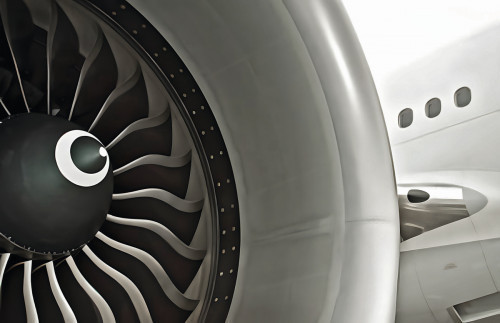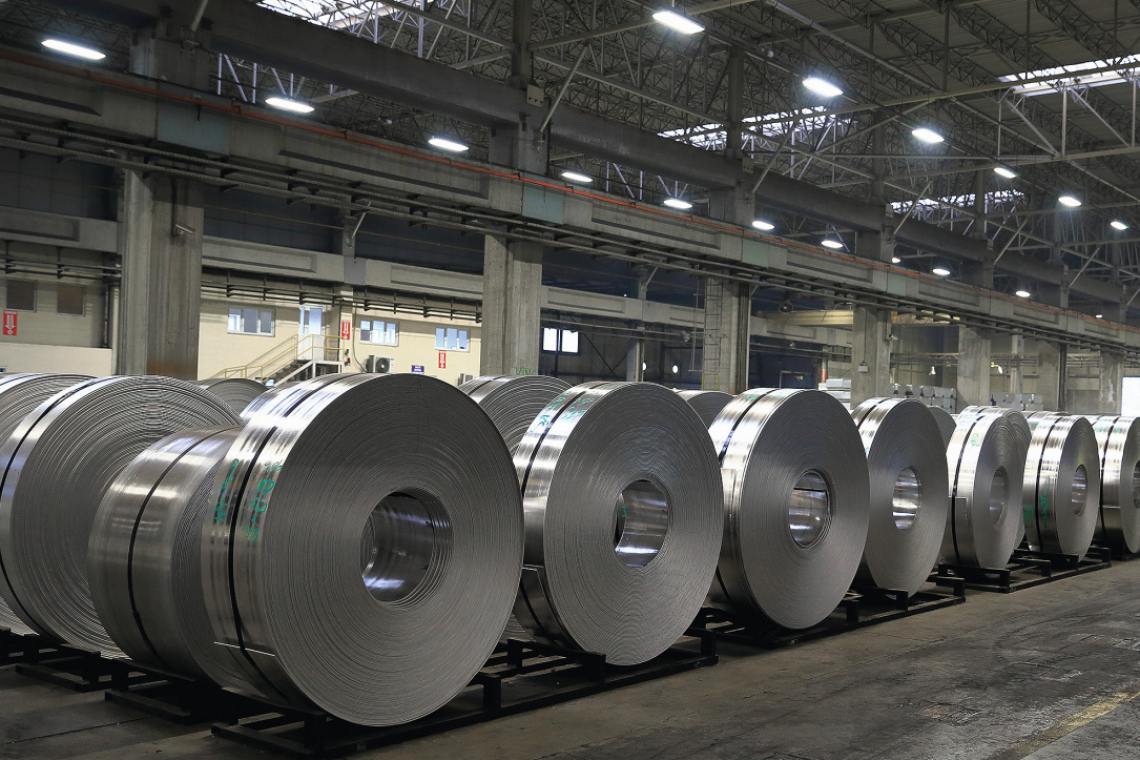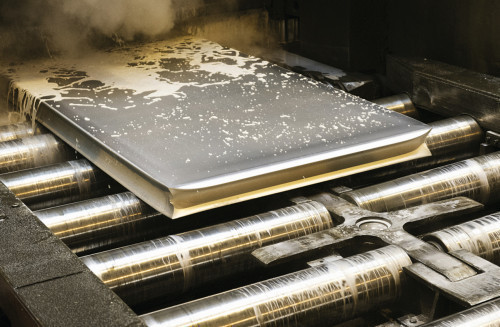- Part 2 - Aluminum alloys: Production, processing and applications / Continued from Galvanotechnik 11/2023
Aluminum is a versatile light metal with applications ranging from mechanical engineering and aerospace to the packaging industry. The various manufacturing processes for semi-finished aluminum products are closely linked to the type of application and the production of components. These are offered as plates, sheets and foils or as profiles. The semi-finished aluminum product can be specifically tailored to the area of application and thus the most cost-effective semi-finished product variant can be selected for further processing. In most cases, aluminum is used as an alloyed light metal.
The alloying elements influence the properties of the light metal and are used, among other things, to improve strength, corrosion properties, toughness or machinability. Of course, pure aluminum with > 99% aluminum is also used, for example in the packaging industry. To produce an alloy, various alloying elements such as magnesium (Mg), silicon (Si), manganese (Mn), zinc (Zn) or copper (Cu) are added to the molten aluminum in varying concentrations. Material properties such as strength and machinability are also specifically controlled by appropriate heat treatment processes during and after the production of the semi-finished aluminum products (Table 1).
|
DIN EN 573-3 |
Designation |
Alloy |
General properties surface treatment, weldability, |
| 1050A | Al99.5 |
Si 0.25% |
Corrosion resistance: |
| 1080A | Al99.8(A) |
Si 0.15% |
Corrosion resistance: |
| 2024 | AlCu4Mg1 |
Si 0.5% |
Corrosion resistance: |
| 5005A | AlMg1 |
Si 0.3% |
Corrosion resistance: |
| 5083 | AlMg4.5Mn0.7 |
Si 0.4% |
Corrosion resistance: |
| 5754 | AlMg3 |
Si 0.4% |
Corrosion resistance: |
|
DIN EN 573-3 |
Designation |
Alloy |
General properties surface treatment, weldability, |
| 6061 | AlMg1SiCu |
Si 0.4-0.8% |
Corrosion resistance: |
| 6082 | AlSi1MgMn |
Si 0.7-1.3% |
Corrosion resistance: |
| 7022 | AlZn5Mg3Cu |
Si 0.50% |
Corrosion resistance: |
| 7075 | AlZn5.5MgCu |
Si 0.40% |
Corrosion resistance: |
Once the alloy has been matched, the molten aluminum is poured into aluminum ingots. The aluminum ingots are further processed in the rolling process or by extrusion.
The production of cast parts is another type of shaping. The component is usually cast into its finished geometry (sand casting, permanent mold casting) or injected (die casting). In most cases, only minor finishing work, such as deburring or simple mechanical processing, is then required to obtain a finished component. You can find out more about casting and extrusion in the January issue.
The choice of semi-finished aluminum product is determined by the component geometry, mechanical processing options, component requirements and, of course, ultimately the costs.
Manufacturing process - rolling aluminum
The rolling of aluminum is an important process used in the production of aluminum plates, sheets, strips and foils. There are various rolling processes, including hot rolling, cold rolling and hot-cold rolling.
Rolling mills usually consist of reversing stands, which work in the forward and reverse direction, as well as conveyors and set-up systems.
Rolling mills are up to 350 meters long and operate at speeds of up to 2000 meters per minute. The rolls are precisely designed and the process sequences are constantly monitored to ensure the desired dimensions and tolerances.
The starting material for hot rolling is rectangular, extruded aluminum ingots. These can have dimensions of up to 0.6 meters thick, 2.7 meters wide and up to 9 meters long. The ingots can weigh up to 32 tons. Transporting and handling the aluminum ingots alone is a challenge.
Before the rolling process, the cast aluminum ingots are stripped of their cast skin so that no impurities are introduced into the rolling process. For this purpose, the aluminum ingots are trimmed on one or both sides and milled over the entire surface.
If oxides from the cast skin are unintentionally rolled into the rolled product during further processing, this results in visible defects in the surface quality. For decorative surface qualities or anodized quality, more material is removed and discarded during this mechanical processing of the ingots. As a result, these material qualities are also priced higher.
Basics of hot rolling aluminum
Hot rolling is a forming process in which the aluminium is rolled at elevated temperatures above its recrystallization temperature. This temperature is usually between 350 °C and 540 °C, depending on the alloy and the desired mechanical properties of the end product. Hot rolling makes the aluminum softer and more malleable, which leads to better formability and surface quality.
During hot rolling, the rolled material is moved back and forth through the rolls in several passes. The distance between the rolls is reduced at each step until the desired thickness of the material is achieved. Depending on the alloy, this can be done in 10 to 25 passes up to a thickness of 34 mm.
The end pieces are then cut off at the crested shears, preparing the product for the next step. The rolled product is either folded or sawn to a specified size for the production of panels.
Further rolling processes, usually in a single pass, reduce the material thickness to up to 2 mm. This takes place at rolling speeds of up to 480 meters per minute. The strips are wound into coils with a diameter of up to 2.7 meters on the coiler. Integrated measuring and control technology guarantees a consistent quality standard.
Hot rolling process sequence
The process of hot rolling aluminum (Fig. 1) comprises several steps:
- Preparation of the material: first, the aluminum is prepared in the form of continuous cast aluminum ingots or slabs. The ingots are heated to the appropriate hot rolling temperature. This temperature allows the aluminium to recrystallize, rearranging its internal structure and making it softer.
- Hot rolling: The aluminum, heated to the correct temperature, is passed between several pairs of rollers arranged one behind the other or moved back and forth via reversing stands. These rolls reduce the thickness of the material and shape it into the desired form.
- Cooling: After hot rolling, the aluminum is cooled to room temperature to prevent excessive grain growth. This improves the mechanical properties and surface quality of the end product.
Advantages of the process
- Improved formability: By reaching higher temperatures, the aluminum becomes softer and easier to form.
- Better mechanical properties: Recrystallization during hot rolling leads to finer grain structures and therefore improved mechanical properties such as strength, ductility and elasticity.
- Higher surface quality: Hot rolling improves the surface quality and reduces defects such as scratches and cracks.
- Energy efficiency: Forming at elevated temperatures reduces the forming resistance, which leads to a reduction in energy consumption.
Applications and further processing
The applications of hot-rolled aluminum plates and sheets are diverse and range from the automotive industry, aerospace technology and vacuum technology to machine and mold construction.
Aluminum plates are often shaped into the desired component form by milling, drilling and turning. Sheet metal is usually processed using laser or water jet cutting or shaped in punching and folding machines.
The challenges
Despite the many advantages and possible applications, there are also challenges in the hot rolling of aluminum, which have a major influence on the quality of the rolled products.
- Controlled heat treatment: Precise control of the rolling temperature and cooling rates is crucial in order to achieve the desired mechanical properties and avoid undesirable defects.
- Material selection: Not all aluminum alloys are equally suitable for hot rolling. The alloy composition and process must be carefully matched.
- Surface quality: Although hot rolling improves surface quality, surface defects can still occur that require subsequent machining.
Basics of the aluminum cold rolling process
Cold rolling of aluminum refers to the forming of aluminum sheet or strip at room temperature using pressure. In contrast to hot rolling, which is carried out at elevated temperatures, cold rolling offers some key advantages. These include improved surface quality, greater dimensional accuracy and higher strength of the end product.
The cold rolling process begins with pre-cutting the aluminum strips to the desired dimensions. The strips are then passed through a series of rolling stages that gradually reduce the thickness and create the desired shape. This process requires precise control of rolling forces, speeds and cooling to achieve both the shape and the desired material properties. Depending on the alloy and the required strength, the cold-rolled strips must be annealed again between the individual passes. This takes place in single-chamber annealing furnaces under a nitrogen protective gas atmosphere to prevent oxidation of the aluminum.
Influence on the material properties
Cold rolling influences a variety of material properties of aluminum, including strength, hardness, ductility and surface finish. By reducing the thickness and strengthening the structure during cold rolling, the grain structure of the metal is refined, resulting in increased strength and hardness. At the same time, the ductility of the material can decrease, which must be taken into account in some applications.
The surface quality of cold rolled aluminum is generally excellent, making it suitable for applications where a smooth and aesthetically pleasing surface is required.
Significance
Cold rolling aluminum is an important process that greatly expands the versatility of this metal. By precisely controlling the rolling process, a wide range of material properties can be produced and applications in various industries can be served. From the construction industry to electronics, cold rolled aluminum has made a significant contribution to modern technologies and products.
Applications
Rolled aluminum is used in a variety of industries. A common example is the production of aluminum sheets for the construction industry, which are used in cladding, roofing and other architectural elements. The automotive industry uses cold-rolled aluminum for car body parts, due to the combination of low weight and sufficient strength.
Cold-rolled aluminum is also frequently used in the packaging industry for the production of food packaging due to its barrier effect against light, oxygen and moisture. Electronics and electrical engineering also benefit from the properties of rolled aluminum, for example for the housings of electronic devices.
Building industry:
- Sheets and plates for roof coverings
- Wall cladding and facade cladding (Figure 2)
- Floor coverings and stair treads
Automotive industry:
- Car body panels
- Interior trim and cladding elements
- Hubcaps and trim strips
Packaging:
- Aluminum foils for food packaging (Fig. 3)
- Containers and cans
Electronics:
- Enclosures for electronic devices and components
- Heat-dissipating elements such as coolers and heat sinks
 Fig. 4: Aircraft industry (Photo: private)
Fig. 4: Aircraft industry (Photo: private)
Aerospace:
- Aircraft components such as wings and fuselage panels (Fig. 4)
- Aerospace structures and fairings
Lightweight construction:
- Lightweight components for machines and systems
- Lightweight structures for sports equipment
Food industry:
- Aluminum sheets for food processing
- Production of cookware and baking tins
Shipbuilding:
- Ship components and cladding
- Marine structures and profiles
Medical technology:
- Medical housings and claddings
- Structural elements for medical devices
Consumer goods:
- Designer furniture and accessories
- Household items such as pots, pans and crockery
Solar energy:
- Solar panels and solar cells
Transportation:
- Housing for public transportation
- rail vehicles
Education:
- Boards and board frames for schools and educational institutions
Industrial applications:
- Sheet metal for machine cladding
- Components for industrial conveyor belts
The versatile properties of aluminum, such as its corrosion resistance, low density and good formability, make rolled products indispensable in many different applications. The rolling processes described and the rolled products manufactured with them, such as plates, sheets and even the thinnest foils, enable a wide range of uses.
The properties of the light metal, which are controlled by the alloys and heat treatments, support this variety of applications. Rolled aluminum products have become an integral part of our daily lives. This starts with wrapping breakfast in aluminum foil, opening a beverage can, using the car or public transport and even leisure activities. The type of manufacturing process is already taken into account during the planning phase of components and material properties are coordinated. The requirements of a component and the economic aspect are always in focus.
Two other important manufacturing processes are the extrusion of aluminum and the various aluminum casting processes. These two processes, which are also formative and have become an integral part of aluminum processing, will be discussed shortly.





